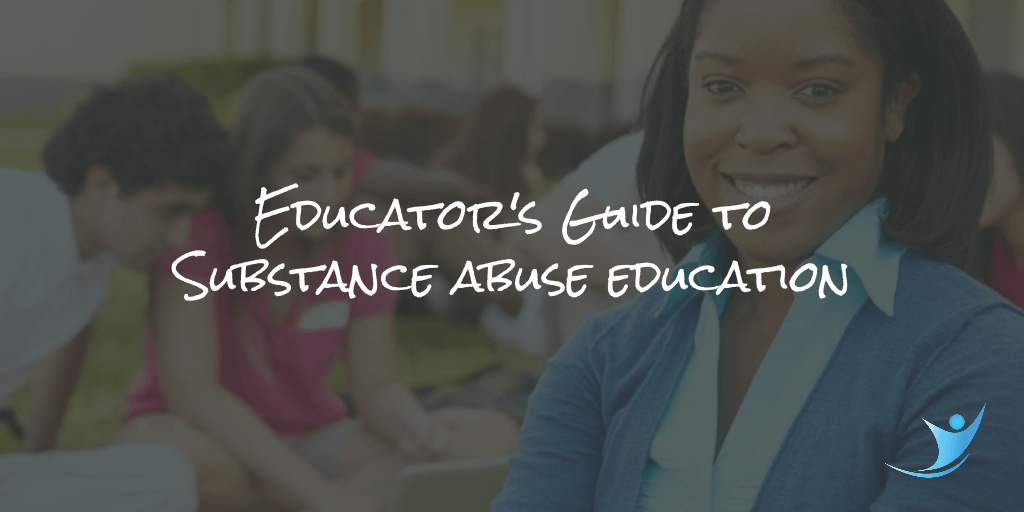Table of content
JOIN FREE GROUP
All About Recovery
Facebook Group • 2213 members
There's always clouds before the rainbows. Join many others who are going through the same thing as you and see proof that it can get better.
JOIN FREE GROUP Educator’s Guide To Substance Abuse Education

Drug education in the classroom can be a very important protective factor when it comes to helping youth make healthy decisions when it comes to substance related decisions. For teachers, this requires honest and factual dialogue for this education to be effective. The environment that the teachers create must be supportive. Having an environment that youth can feel comfortable expressing themselves in can increase information preservation.In the classroom setting, substance use can be a very sensitive issue for some students so it is important that teachers facilitate an environment that is free of moralization and judgment but also to set healthy boundaries for these discussions.The best way to arrive at this balance is through a group agreement, established by both the teacher and the students. This joint effort promotes ownership and will foster mutual respect and establish a setting in which students feel comfortable to both listen to and discuss others’ experiences and opinions.
The environment that the teachers create must be supportive. Having an environment that youth can feel comfortable expressing themselves in can increase information preservation.In the classroom setting, substance use can be a very sensitive issue for some students so it is important that teachers facilitate an environment that is free of moralization and judgment but also to set healthy boundaries for these discussions.The best way to arrive at this balance is through a group agreement, established by both the teacher and the students. This joint effort promotes ownership and will foster mutual respect and establish a setting in which students feel comfortable to both listen to and discuss others’ experiences and opinions.
[/su_table]
 The environment that the teachers create must be supportive. Having an environment that youth can feel comfortable expressing themselves in can increase information preservation.In the classroom setting, substance use can be a very sensitive issue for some students so it is important that teachers facilitate an environment that is free of moralization and judgment but also to set healthy boundaries for these discussions.The best way to arrive at this balance is through a group agreement, established by both the teacher and the students. This joint effort promotes ownership and will foster mutual respect and establish a setting in which students feel comfortable to both listen to and discuss others’ experiences and opinions.
The environment that the teachers create must be supportive. Having an environment that youth can feel comfortable expressing themselves in can increase information preservation.In the classroom setting, substance use can be a very sensitive issue for some students so it is important that teachers facilitate an environment that is free of moralization and judgment but also to set healthy boundaries for these discussions.The best way to arrive at this balance is through a group agreement, established by both the teacher and the students. This joint effort promotes ownership and will foster mutual respect and establish a setting in which students feel comfortable to both listen to and discuss others’ experiences and opinions. Have an Inclusive Group Agreement
To be effective, Group Agreements should be covered at the beginning of each discussion and should be standard.An effective Group Agreement could look like this:- If you wish to speak, raise your hand
- If you do not want to speak, that’s okay
- No Cross-talk…when someone is speaking, no interruptions
- No one person should dominate the discussion
- Use depersonalization techniques
Depersonalization Techniques
An important aspect to setting up an effective Group Agreement is to discuss the teacher’s and student’s rights to privacy. It is advised not to share your own, or anyone else’s personal, private or confidential information.An effective way to handle potentially sensitive topics is to use techniques to depersonalize the discussion. Using the third person, role playing or using fictitious characters to convey a message are all effective methods in this regard.A technique that I’ve used in the classroom is to have the class come up with two names, for example, Ralph and Gertrude. I would then have a student write these names on the Whiteboard, Flip Chart etc.…From this point the group would know that every story, experience, situation or question that they discuss or describe should be about either Ralph or Gertrude.If a student would start conversation with a personal or first-person exposition, a simple point to the names on the whiteboard would quickly switch them to depersonalizing the narrative.Teacher Tips for Talking about Substance Use in the Classroom
Substance use may be a topic that some youth have never been previously educated about. This may mean they have lots of questions and concerns. By allowing youth the express themselves and ask questions, teachers can support healthy youth development.If a question is asked that you are unfamiliar with, be honest and admit that you do not have the answer but that you will make every effort to find the answer and get back to the individual who posed the question. This will validate the youth’s participation in the discussion and will build rapport between teacher and student.To ensure the discussions have a balance of factual information, it is best to stick to a few basic guidelines;- Discuss why people use and discuss alternatives to substance abuse
- Present honest facts; accurate & balanced about the dangers, short term effects and the user perceived benefits of using/not using
- The Canadian Centre For Addictions are an excellent resource on substance use facts. They can be found at https://canadiancentreforaddictions.org/understanding-addiction/
- Focus on short term effects when discussing drug specific information as long term effects are viewed as almost inapplicable to them at this point in their life
- Remember that youth dismiss information contradictory to their experience or reflecting adult exaggeration
- Make special mention of the high percentage of students who are not using; dispelling the notion that many students are using
- Address substances with a pattern of use in the community
- Focus on a single substance classification per module rather than addressing several classifications all at once
- Promote protective factors
- Discuss critical thinking, what it is, and how to apply it towards issues of substance use
- Discuss awareness of media and peer influence
- Stay neutral and acknowledge all contributions in the same manner, this helps propel healthy discussion
- Keep discussions moving in a positive direction by questioning or posing hypothetical situations that encourage deeper thinking on the topic
- Encourage all students to participate in conversations, but never force a student to participate. If a group is particularly quiet, asking students to write out their questions/responses on a piece of paper could help ease them into the discussion
- At the end of discussions, always ask students to summarize the key points
Why do youth use substances?
In order to maintain credibility on the topic of youth substance use it is essential to take the time to try to understand youth as it pertains to substance use. Youth turn to drugs for many of the same reasons that adults do;- Temporarily relieve stress
- Escape or distract from emotional pain
- The need to take risks
- Constant questioning of self-worth
- Establishing independence or autonomy
- Demonstrating attitudes and ideals that are different from their parents or from society
- Acceptance into a peer group
- Satisfying curiosity
- Unchallenged perception of how prevalent drug use is (media, social groups and the assumption that everyone is doing it
- Using substances to maintain an identity or an image
Youth Development
- Information seeking
- Educators need to help students know where to get credible information and to be able to distinguish what is credible information
- It’s not considered “best practice” to rely on information found on personal blogs, public forums, unreferenced articles
- Teachers should convey to youth the importance of using 2 or 3 sources to solicit information on any drug related subject to formulate a well-educated opinion.
- Problem Solving
- Youth are developing themselves and this involves being able to develop problem solving skills for issues that may arise
- It is key for youth to be able to identify what the problem is and identify options for change on their own
- It is helpful to write down problem and all brainstormed options
- Refusal Skills
- Teachers can help students find effective strategies to managing Peer Influence situations in relation to substance use. Refusal Skills must be adapted to the demographics of each particular discussion / classroom
- Make a joke / Humour
- Give a reason why it’s a bad idea.
- Make an excuse why you can’t.
- Just say no, plainly and firmly.
- Suggest an alternative activity
- Ignore the suggestion
- Repeat yourself if necessary
- Leave the situation
Media Awareness
Educators must acknowledge that there is vast amount of marketing and advertising that youth experience. Movies, music, video games and other media don’t always accurately portray the risks of drug usage. Teachers must be able to dispel misinformation and help youth understand and determine how and where to get credible information.- Doctors
- Pharmacists
- Libraries
- Reputable websites
Youth and Social Norms
Adolescents tend to overestimate how many of their peers engage in substance use. Consistent with the Social Influences Model, it is important to bring to the attention of youth how many of their peers are not using substances. This dispels any misperceptions and provides support for youth who feel pressured to use to fit into the “social norm”. Activity #1: Promoting Resiliency Brainstorm and discuss examples of Protective and Risk Factors with class and capture results on chart paper/blackboard/whiteboard etc.Define: Protective Factors, Risk factors and Resiliency1) Protective factors – aspects of a youth's environment that make them less likely to use drugs2) Risk factors – aspects of a youth's environment that make them more likely to use drugs3) Resiliency - ability to cope with adversity in a situation that is not readily open to changeSome examples:[su_table]| Risk Factors | Protective Factors |
| Low self esteem | Healthy self esteem |
| Disorganized or disrupted home or family stressors (poorly defined rules etc.) | Nurturing attachment to parent(s) / caregiver |
| Physical, Emotional, Sexual abuse | Drug education in schools |
| Substance use amongst friends/peers | Limited exposure to drug availability in community |
| Exposure to drug availability in community | Positive, quality relationship with at least one other adult other than parent |
| Youth’s perception of drugs harm/risk | Feeling of acceptance and connection (school community, social clubs, sports, extracurricular activities) |
| Major transitions in youth’s life (divorce, entering high school, changing schools | Effective and accessible parental communication |
| Substance dependency of parent(s) or family member | Adequate housing |
| Large, overcrowded family | Good problem-solving skills |
| Mental health Issues | Socially adept |
Substance Use, Misuse and Abuse
Describing Substance Use, Misuse and Abuse can be instrumental in helping youth understand and identify the differences between experimental use or when substance use is becoming a problem.Substance use would include using a specific medication, or substance, as prescribed or intended. For example, using Tylenol as prescribed for a headache. Misuse would be if an individual started increasing the frequency or dosage of the prescribed instructions or if they used for reasons other than what the substance is originally intended for, eg. Taking 6 Tylenol’s because I feel overwhelmed at school. Substance abuse is when there is a prevalence, or a pattern of this misuse.Understanding the difference between use, misuse and abuse is important because it allows for real and factual conversation about drugs and alcohol. A common trend for authority figures such as Teachers or parents (who should read this article on how to talk to their own kids about drugs) when discussing drugs with young people is to embellish and provide overwhelmingly negative data with the hope that this information will serve as enough of a deterrent to scare youth away from using drugs and alcohol. These scare tactics serve only to present the position to students as unauthentic, disingenuous and dishonest. Once you lose credibility with regards to topics as important as this, it is very hard to regain their ear let alone their trust.The scare tactic approach results in most subsequent dialogue being dismissed in the future. I have years of experience working with youth ages 10 to 25. As a father of two adult children and with my experience talking to kids in the classroom and in the addiction treatment environment, I can tell you that the Regan era Just Say No and This is Your Brain on Drugs methodologies do not work. Eggs fry as soon as they touch a hot surface, but what does this have to do with kids who have seen their friends smoke a joint or drink a beer and nothing bad happened?An egg and a hot pan are very different than a person’s brain and a beer, or a brain and a benzodiazepine. This information serves as a disconnect from reality and the underlying message is both lost and discredited almost instantly. When a teacher presents the notion that if you smoke marijuana, you will lose your memory, never be motivated to be successful or ruin your life, it discredits from the possible life experiences that the youth may already know a person already who uses or has used marijuana, that did not lose their memory, they didn’t die, they didn’t quit school or work and that person may even be quite successful.What happens next is that the educators’ view of the substance comes into question and then is often disregarded as nothing more than a manipulative tactic to further control and to have decisions made for them. During discussions with youth about drugs, it’s important to include a balance in the information. This helps to prevent your discussion as being viewed as biased and with an ulterior agenda.ACTIVITY #2: Triangle of Decision The purpose of this activity is to engage students into though provoking discussion regarding important and relevant substance use topics. There are no right or wrong answers, teachers are to facilitate healthy discussion and debate. This also helps teachers identify what the common thoughts or opinions that their class has on certain topics and can allow for effective education as follow up to help identify any misinformation.Supplies required: chart paper and easel or whiteboard to write down questions/statements.- Teacher will ask questions and present statements about youth and drug use such as:
- Smoking Marijuana is harmless
- Drug use is a normal part of growing up
- You can use drugs without becoming addicted
- You can use alcohol without becoming addicted
- Addicton: Is it a choice or is it a disease?
- Three corners/areas of the room will be labeled, ‘Agree’, ‘Disagree’, ‘Unsure
- Students will consider the statements or questions written on th flip chart / whit board and then move to the corner of the room that best reflect their viewpoint.
- Teachers will initiate discussion by asking individuals to explain their corner choice. Participants will also be able to change corners if their opinion changes.




